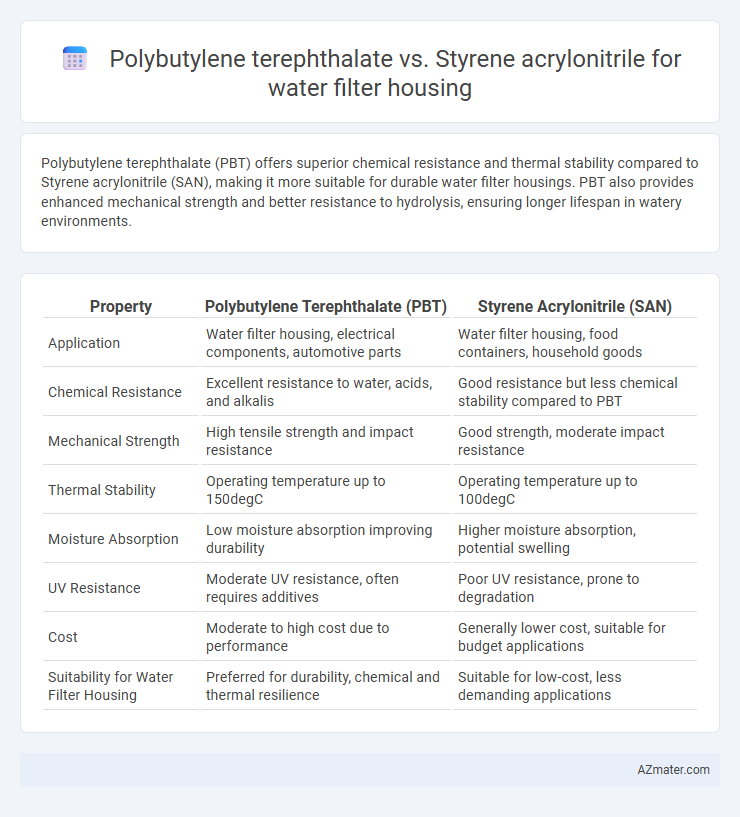Polybutylene terephthalate (PBT) offers superior chemical resistance and thermal stability compared to Styrene acrylonitrile (SAN), making it more suitable for durable water filter housings. PBT also provides enhanced mechanical strength and better resistance to hydrolysis, ensuring longer lifespan in watery environments.
Table of Comparison
| Property | Polybutylene Terephthalate (PBT) | Styrene Acrylonitrile (SAN) |
|---|---|---|
| Application | Water filter housing, electrical components, automotive parts | Water filter housing, food containers, household goods |
| Chemical Resistance | Excellent resistance to water, acids, and alkalis | Good resistance but less chemical stability compared to PBT |
| Mechanical Strength | High tensile strength and impact resistance | Good strength, moderate impact resistance |
| Thermal Stability | Operating temperature up to 150degC | Operating temperature up to 100degC |
| Moisture Absorption | Low moisture absorption improving durability | Higher moisture absorption, potential swelling |
| UV Resistance | Moderate UV resistance, often requires additives | Poor UV resistance, prone to degradation |
| Cost | Moderate to high cost due to performance | Generally lower cost, suitable for budget applications |
| Suitability for Water Filter Housing | Preferred for durability, chemical and thermal resilience | Suitable for low-cost, less demanding applications |
Introduction to Water Filter Housing Materials
Polybutylene terephthalate (PBT) offers excellent chemical resistance, high mechanical strength, and thermal stability, making it ideal for durable water filter housing. Styrene acrylonitrile (SAN) provides clarity and good impact resistance but is less resistant to high temperatures and harsh chemicals compared to PBT. Selecting between PBT and SAN depends on the specific water filtration environment, balancing durability, chemical compatibility, and transparency requirements.
Overview of Polybutylene Terephthalate (PBT)
Polybutylene Terephthalate (PBT) is a thermoplastic polymer widely used in water filter housings due to its excellent chemical resistance, high mechanical strength, and dimensional stability. Its resistance to hydrolysis and low moisture absorption make PBT ideal for prolonged contact with water, preventing degradation and maintaining structural integrity. Compared to Styrene Acrylonitrile (SAN), PBT offers better thermal stability and durability, enhancing the performance and lifespan of water filtration systems.
Overview of Styrene Acrylonitrile (SAN)
Styrene Acrylonitrile (SAN) is a copolymer known for its excellent chemical resistance, high strength, and clarity, making it a preferred choice for water filter housings where durability and visual inspection are critical. Compared to Polybutylene Terephthalate (PBT), SAN offers superior resistance to hydrolysis and a lower moisture absorption rate, enhancing longevity in wet environments. SAN's rigidity and dimensional stability under varying temperatures contribute to reliable sealing and structural integrity in water filtration applications.
Mechanical Strength Comparison
Polybutylene terephthalate (PBT) offers superior mechanical strength for water filter housing due to its high tensile strength, excellent impact resistance, and dimensional stability under stress. Styrene acrylonitrile (SAN) exhibits moderate mechanical properties but is more brittle and less resistant to impact compared to PBT. PBT's enhanced durability and resistance to deformation make it the preferred choice for applications requiring robust mechanical performance in water filter housings.
Chemical Resistance in Water Filtration
Polybutylene terephthalate (PBT) exhibits superior chemical resistance compared to Styrene Acrylonitrile (SAN) in water filtration applications, with enhanced durability against chlorine and acidic contaminants commonly found in water supplies. PBT's resistance to hydrolysis and oxidative degradation ensures long-term performance and structural integrity in filter housings exposed to varying pH levels and disinfectants. SAN, while cost-effective and mechanically robust, shows lower resistance to aggressive chemicals, making it less suitable for filters in environments with high chemical exposure.
Thermal Stability and Temperature Performance
Polybutylene terephthalate (PBT) offers superior thermal stability with a melting point around 223degC, enabling consistent performance in high-temperature water filtration environments compared to Styrene acrylonitrile (SAN), which has a lower heat distortion temperature near 100degC. PBT maintains structural integrity under thermal cycling and resists deformation at elevated temperatures, making it ideal for hot water filter housings. SAN, while chemically resistant and transparent, may soften or warp under extended thermal exposure, limiting its effectiveness in high-temperature applications.
Food Safety and Regulatory Compliance
Polybutylene terephthalate (PBT) is highly favored for water filter housings in food safety applications due to its excellent resistance to chemicals, high temperature tolerance, and compliance with FDA regulations for indirect food contact. Styrene acrylonitrile (SAN) offers good mechanical strength and clarity but typically falls short in meeting stringent FDA and NSF certifications required for potable water systems. Manufacturers prioritize PBT in water filter housings to ensure regulatory compliance, chemical inertness, and long-term durability in food and beverage filtration contexts.
Durability and Longevity in Use
Polybutylene terephthalate (PBT) offers superior chemical resistance and structural integrity, making it highly durable for water filter housing applications exposed to various water contaminants. Styrene acrylonitrile (SAN), while providing good rigidity and clarity, tends to be less resistant to prolonged exposure to heat and chemicals, potentially reducing its longevity. PBT's enhanced thermal stability and resistance to hydrolysis significantly extend the service life of water filter housings compared to SAN.
Cost-Efficiency and Manufacturing Considerations
Polybutylene terephthalate (PBT) offers superior chemical resistance and thermal stability, making it cost-efficient for durable water filter housings, though its higher raw material cost impacts initial expenses. Styrene acrylonitrile (SAN) provides lower material costs and easy moldability, reducing manufacturing time and costs but may require additional additives to match PBT's longevity in water exposure. Manufacturers must balance PBT's long-term performance and SAN's upfront affordability when selecting materials for water filter housings.
Conclusion: Choosing the Right Material for Water Filter Housings
Polybutylene terephthalate (PBT) offers superior chemical resistance, mechanical strength, and thermal stability, making it ideal for demanding water filter housing applications. Styrene acrylonitrile (SAN) provides excellent clarity and impact resistance but lacks the high temperature tolerance and chemical durability of PBT. Selecting PBT ensures enhanced longevity and performance in harsh water filtration environments, whereas SAN suits applications prioritizing transparency and moderate mechanical stress.

Infographic: Polybutylene terephthalate vs Styrene acrylonitrile for Water filter housing
 azmater.com
azmater.com